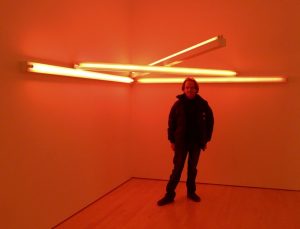Architect Bud Brannigan's search for a good coffee during a four day stint in Singapore recently brought him to the multitasking and ever-welcoming land of Potato Head Folk.
Sign up to the
monthly newsletter



Set in a charming 1939 building that traces a luscious curve around a corner in Chinatown, Potato Head’s four levels of space each cater to a different mood, and a different crowd, or perhaps to the same crowd at different times of day.
For anyone who has visited Bali’s Potato Head Beach Club in Seminyak, the world of Folk is entirely another one, and built to a more domestic scale. The Bali venue creates a beachfront fantasyland of pavilions of bars, lounges and dining rooms sprawled around pools, manicured lawns and lush beachside gardens. The scale, like the atmosphere, is inflated, dazzling, and screams ‘party’ from every pore and niche. It is a paradise for voyeurs and narcissists alike.



Singapore’s PH expounds a new take on fun, and establishes a more homely space suited to the demure scale of the building and its context. Artist David Bromley’s signature storybook innocents decorate the walls and tables, recalling a past era of childhood that nudges the boundaries of kitsch. Here’s what Bud found besides the coffee, which, by the way, was good…

“When I was invited to Singapore for the ERCO lighting workshop, I researched where was the best coffee in town. Potato Head kept popping up, so a few of us went there after the first day of product learning and case studies.
“The building is a real surprise and like so much architecture in Singapore, it takes design by the throat. It has a small footprint, with the sculptural form of the building mirroring the shape of the footpath. The context is very tight and the street is lined with historic shop houses, making for a delightful scale. Across the road in an old shop house is The Study, a whisky bar where the spaces are so small only a few people are invited in (via an app) at a time.



“Inside there’s so much happening — so much in a small area. We arrived first on a Saturday night to a DJ playing blues. Three Buns Burgers are served on the first floor, and our Spongebob style Krabby Patty consisted of a chunk of blue swimmer crab with coriander and chilli on an artisan bun.
“The ground floor spills out onto the street,, whee intrepid people who don’t mind the heat can sit and watch the local scene. Inside, David Bromley’s works fill all the spaces. A winding central stair with its floor covered in checkerboard black and white tiles means you can look up and down the three internal levels. The stairwell itself is surrounded in artwork — it is an absolutely lovely place to be. Eclectic furnishings make it feel very homely and un-polished. All the fixtures and fittings are attached to walls and ceilings, so nothing is concealed and the original structure maintains its integrity.”



“Japanese T-shirt gurus Neighbourhood have set up shop inside so you can eat a burger, sip a guava mojito or whatever, and buy the merchandise. The rooftop bar is tiny, but of course the roof is where everyone wants to be in Singapore. If you’re one of the lucky few who fit there, you can catch the sea breeze.”

About the Contributor
Bud Brannigan
Bud Brannigan is the Director of Bud Brannigan Architects in Brisbane, with project experience both locally and in regional areas of Queensland and New South Wales. The practice has been honoured with several awards from the Australian Institute of Architects, most notably the national Robin Boyd Award for residential architecture in 1994. In 2007 Bud received a Churchill Fellowship to study regional museums in the USA, and in 2011 the practice was shortlisted to design the new Australian pavilion for the Venice Biennale. More recently, Bud Brannigan Architects completed the Margaret Olley Art Centre at the Tweed Regional Gallery, which opened in March 2014.


